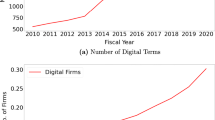Abstract
In this paper we compare the relationship between a firm’s innovation capital and the likelihood that a firm will commercialize an invention. Our index of innovation capital is the product of the firm’s human capital, social capital, and reputational capital. We find from our empirical experiment, which uses Small Business Innovation Research data, that innovation capital is a statistically more important entrepreneurial input to the innovation output of commercialization than any of its components.
Similar content being viewed by others
Notes
Kijek (2012) provides an excellent literature review of the topic innovation capital.
Current funding guidelines allow, under certain conditions, an agency to increase Phase I and Phase II awards by up to 50%.
After the SBIR program was reauthorized in 2008, Congress again asked for a survey and a series of case studies. This second wave of SBIR data was collected in 2011 and 2014. While some data from the second data collection effort was available to us, to maintain confidentiality of the awarded firm the dollar amount of the Phase II award was not available. As discussed below, the amount of that award is conceptually an important regressor in our models; thus, the data used herein are from the 2005 NRC survey.
The U.S. SBIR program has been emulated in many countries including Sweden, Russia, the United Kingdom, Japan, Korea, and Taiwan. See Hayter et al. (2018).
While we do not have information on the reasons that a particular firm would receive previous and related Phase II awards, the finds that we present below might be interpreted as suggestive evidence of what Antonelli and Crespi (2013) have called a virtuous Matthew effect.
See Kijek (2012).
Cited from Audretsch and Lehmann (2016).
References
Antonelli, C., & Crespi, F. (2013). The ‘Matthew Effect’ in R&D public subsidies: The Italian evidence. Technological Forecasting and Social Change, 80, 1523–1534.
Audretsch, D. B., & Lehmann, E. E. (2016). The seven secrets of Germany: Economic resilience in an era of global turbulence. New York: Oxford University Press.
Audretsch, D. B., & Link, A. N. (2019). Sources of knowledge and entrepreneurial behavior. Toronto: University of Toronto Press.
Audretsch, D. B., & Stephan, P. E. (1996). Company-scientist locational links: The case of biotechnology. American Economic Review, 86, 641–652.
Becker, G. S. (1993). Human capital: A theoretical and empirical analysis, with special reference to education (3rd ed.). Chicago: University of Chicago Press.
Coleman, J. (1988). Social capital in the creation of human capital. American Journal of Sociology, 94, 95–121.
Dyer, J., & Furr, N. (2018). Innovation capital: The secret ingredient behind the world’s most innovative leaders. Forbes, September 4. https://www.forbes.com/sites/nathanfurrjeffdyer/2018/09/04/innovation-capital-the-secret-ingredient-behind-the-worlds-most-innovative-leaders/#31834c0b5fd3. Accessed 6 Sept 2018.
Hayter, C. S., Link, A. N., & Scott, J. T. (2018). Public-sector entrepreneurship. Oxford Review of Economic Policy. https://doi.org/10.1093/oxrep/gry014.
Kijek, T. (2012). Innovation capital and its measurement. Journal of Entrepreneurship, Management and Innovation, 8, 52–68.
Lazear, E. P. (2005). Entrepreneurship. Journal of Labor Economics, 23, 649–680.
Leyden, D. P., & Link, A. N. (2015a). Public sector entrepreneurship: U.S. technology and innovation policy. New York: Oxford University Press.
Leyden, D. P., & Link, A. N. (2015b). Toward a theory of the entrepreneurial process. Small Business Economics, 44, 475–484.
Link, A. N., & Scott, J. T. (2010). Government as entrepreneur: Evaluating the commercialization success of SBIR projects. Research Policy, 39, 589–601.
Link, A. N., & Scott, J. T. (2012). Employment growth from public support of innovation in small firms. Kalamazoo, MI: W.E. Upjohn Institute for Employment Research.
Mansfield, E. (1965). Rates of return from industrial research and development. American Economic Review, 55, 310–322.
Marx, K. (1867). Das Kapital: Kritik der politischen Oekonomie. Hamburg: Verlag von Otto Meissner.
McKelvie, A., Brattström, A., & Wennberg, K. (2018). How young firms achieve growth: Reconciling the roles of growth motivation and innovative activities. Small Business Economics. https://doi.org/10.1007/s11187-017-9847-9.
Paldam, M. (2000). Social capital: One or many? Definition and measurement. Journal of Economic Surveys, 14, 629–653.
Putnam, R. D. (2000). Bowling alone: The collapse and revival of American community. New York: Simon and Schuster.
Schultz, T. W. (1960). Capital formation by education. Journal of Political Economy, 68, 571–583.
Schultz, T. W. (1961). Investment in human capital. American Economic Review, 51, 1–17.
Werner, A., Schröder, C., & Chlosta, S. (2018). Driving factors of innovation in family and non-family SMEs. Small Business Economics. https://doi.org/10.1007/s11187-017-9884-4.
Yang, X., Sun, S. L., & Zhao, X. (2018). Search and execution: Examining the entrepreneurial cognitions behind the lean startup model. Small Business Economics. https://doi.org/10.1007/s11187-017-9978-z.
Author information
Authors and Affiliations
Corresponding author
Rights and permissions
About this article
Cite this article
Audretsch, D.B., Link, A.N. Innovation capital. J Technol Transf 43, 1760–1767 (2018). https://doi.org/10.1007/s10961-018-9700-6
Published:
Issue Date:
DOI: https://doi.org/10.1007/s10961-018-9700-6




